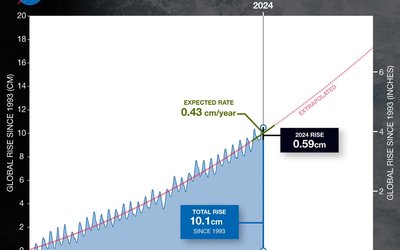Coastal erosion and coastal floods
Multi-century sea level rise may lead to unprecedented threats to coastal cities
January 8, 2022

Shanghai is one of the cities vulnerable to multi-century sea level rise (photo: Stefan Wagener, www.flickr.com)
Sea level rise projections generally focus on the second half of this century, but we all know that sea level will continue to rise for centuries or millennia into the future. Recently a study was published where the authors combined information on long-term projections of sea level rise, coastal elevation, and population density to assess coastal flood risk at the global scale from multi-century sea level rise. They did so for different levels of global warming, ranging from 1.5 °C to 4 °C.
Long-term sea level rise
They showed that 4 °C global warming would lead to 8.9 m of global mean sea level rise somewhere between 200 and 2000 years from now. 1.5 °C global warming would lead to ‘only’ 2.9 m of global mean sea level rise. These numbers are median estimates: a central value in a range of estimates where 50% of the model results are higher and lower than this median value, respectively.
Exposure of population and built environment
It is of course impossible to estimate the population living in low-elevation coastal zones, globally, hundreds of years from now. The authors, therefore, took the current population living near the coast and calculated the extra number of people that would be exposed to coastal flooding at higher sea levels. The built environment, they argue, is largely immovable and the current situation is a good proxy for the future.
Global exposure
Currently, 2.5%–3.0% of the global population (170–200 million) lives in coastal zones that is projected to fall below the high tide line in 2100 if mean sea level were to rise by 0.48–0.73 m. Without adequate flood protection, this part of the global population may be considered vulnerable to coastal flooding by 2100. The authors estimated that 2 °C global warming, the proposed upper limit of the Paris Climate Agreement, would lead to a median 4.7 m of global mean sea level rise on the long run and threaten land now home to roughly 10% of the global population. A pessimistic – upper limit – estimate of 10.8 m of global mean sea level rise following 4 °C global warming could affect land now home to up to one billion people, or 15% of the current global population.
National exposures
East, Southeast, and South Asia face the greatest overall exposure to sea level rise both this century and later. Of all nations with a total population of at least 25 million, Asian countries make up nine of the top ten most at-risk nations. Land home to over half the populations of Bangladesh and Vietnam may become exposed to coastal flooding even if warming is limited to 2 °C.
Many smaller nations, particularly islands, will become extremely vulnerable to coastal flooding. With 2 °C global warming, more than 80% of the population of the Cocos Islands, Maldives, Marshall Islands, Kiribati, Cayman Islands, Tokelau, Tuvalu, and the Bahamas on the long run will be living in land threatened by flooding. With 4 °C global warming, this percentage will be over 90%.
City-level exposures
On the long run, with 4 °C global warming leading to a median projected 8.9 m of global mean sea level rise, at least 50 major cities with a population of at least one million, mostly in Asia, would need to defend against globally unprecedented levels of exposure, if feasible. About half of these cities are also threatened at 2 °C global warming. The vulnerable cities in Asia include megacities with a population over 10 million such as Haora, Shanghai, Hanoi, and Dhaka.
Caveats
A study that looks hundreds of years into the future must be based on assumptions that simplify reality. Taking the current population as a constant for the multi-century scenarios is one of them. Also, the analysis assumes that global emissions do not become negative while in the long run greenhouse gases may be extracted from the atmosphere on a massive scale, reducing long-term sea level rise. On the other hand, no unstoppable collapse of major ice sheets has been included in the analysis while Antarctic ice sheet breakdown may lead to higher multi-century sea levels than projected in this study. Finally, the impact of present or future artificial coastal defenses was not considered.
Source: Strauss et al., 2021. Environmental Research Letters 16.








